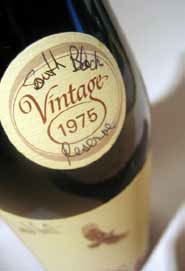Winemaking, Viticulture & Notoriety
At a Gault-Millau-sponsored tasting held in Paris in 1979 called the “Olympics of Wines of the World,” a number
of non-French wines placed near the top. The following year, Robert Drouhin gathered an international
distinguished panel of judges who blind-tasted the wines against burgundies from the cellars of Domaine
Drouhin in Beaune. A 1959 Domaine Drouhin Chambolle-Musigny came in first, but David Lett’s 1975 The
Eyrie Vineyard South Block Reserve Pinot Noir took second, ahead of Domaine Drouhin’s Chambertin. Bill
Hatcher, formerly manager at Domaine Drouhin and now a partner in A to Z Wineworks in Oregon, called the
1975 Eyrie Pinot Noir, “The communion wine of the Oregon Wine Industry.”


Inspired by Rachel Carson’s book, Silent Spring, published in 1962, that decried the use of pesticides in
farming, the Letts practiced strict organic farming from the beginning, never treating the own-rooted, non-irrigated
vines with insecticides, herbicides or systemic fungicides that were in widespread viticultural use in
the 1960s. Eyrie’s commitment predated organic or biodynamic certification, but today, all 60 acres
encompassing five Eyrie vineyards are organically certified. Vine age varies from the vines planted in 1965 to
the newest plantings in 2015.
Until the 1980s, David performed all the important vineyard and cellar work himself and he impressed visitors
with his intimate knowledge of each individual vine. He was an innovator in the vineyard, practicing leaf pulling
to limit yields and vertical trellising, viticulture techniques now widely used in cool climates.
David honed his winemaking craft through a career spanning almost 40 commercial vintages, holding the
distinction of producing a single vineyard Pinot Noir longer than any other winemaker in the United States at
the time of his passing in October 2008 on the eve of harvest at the age of 69.
He tried to pick early enough to retain what he considered the grape’s essential character, relying on de-stemming,
and whole berry, small lot, proprietary yeast fermentations (only in the last decade has the transition
to wild yeast fermentations occurred). Aging was carried out primarily in neutral French oak barrels. Twelve of
the original barrels bought for the 1970 vintage are still in use today (see photo below) and only 15% of the
barrels in the winery are under five vintages old.
The Pinot Noirs were unfined and rarely filtered. The wines remained faithful to a consistent theme of
classically styled Pinot Noir, avoiding trends toward extraction and higher alcohol, and instead seeking balance
and fully evolved acidity that ensured age ability.
The Letts set up a winery in a former food processing warehouse in McMinnville that had cement floors, heavily
insulated walls, low ceilings, and ideal temperature and humidity for winemaking. They rented the original
space for $25 a month, producing their first vintage in the functional but unglamorous facility. They intended to
build a winery on their Dundee Hills estate and even had plans drawn up for it. The estimated cost of $22,000,
which seems piddling today, was beyond their means, and no bank would lend them the money, so they
adapted the warehouse. Although everything had to be done by hand or pump since it was not geared to
forklifts, they found satisfaction in its simplicity, and soon bought the building for $11,000, never to move
despite their intentions and the development of McMinnville all around them. The winery today remains
essentially unchanged from its original configuration.
Production at The Eyrie Vineyards has remained at 8,000 cases annually since 1985. This has been partly the
result of intensive farming and the desire to put quality above all other considerations.
Jason Lett is creating his own legacy at The Eyrie Vineyards since assuming the winemaking and vineyard
management in 2005 despite the weight of preserving the winery’s revered historical significance. He has been
faced with a number of challenges, three of which are highlighted in the following discussion.